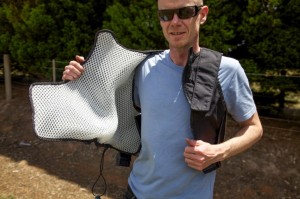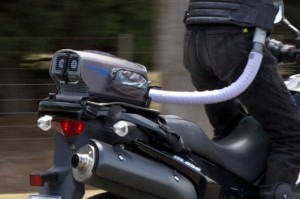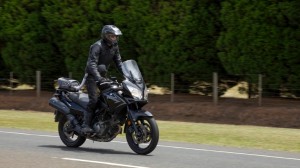REVIEW: ENTROSYS BIKEAIR MOTORCYCLE A/C SYSTEM
February 10, 2014
As someone who likes to have my skin wrapped around my body rather than smeared up and down the highway, I cringe every time I see a motorcyclist cruise past without suitable protective gear on. There is an (albeit still completely flawed) rationale behind this, though – leather jackets, boots, gloves and scrape-resistant pants are hot, heavy and uncomfortable. All of this leaves motorcyclists in an unfortunate predicament because when the weather is at its best, the inclination to pull on protective gear is at its lowest. The EntroSys BikeAir motorcycle A/C system is a product designed to let you enjoy the best of both worlds by providing portable cooling (and heating) for the rider. It sounds great in theory, but does it work? We ventured out under the burning Australian sun to answer that question.
We first encountered Entrosys back in 2010 when the product was still in development. Now on the market in the US and rolling out in Europe, Japan and Australia this year, the BikeAir is made up of a compact A/C unit and a specially-designed cooling vest worn under your regular motorcycle jacket that allows the air to circulate around the torso. Power is supplied by the bike’s battery and the three heating and cooling modes and three fan speeds are controlled wirelessly via a matchbox-sized unit that can be mounted on the bike’s handlebars.
The system achieves its small footprint, light weight (for an air conditioner) of 4.56 kg (10 lb) and low power requirements by using a patented solid-state thermoelectric system rather than compressor-based technology. Given that the only moving parts are the fans, this approach also makes the unit durable enough for use on motorcycles and other open-air vehicles and means it doesn’t use any ozone-depleting gases. The current system is designed for a single rider, but there are also plans for a two-up system for the touring community.
Out of the box
Along with the remote control, vest and the A/C unit itself, the system includes a power cable for connection to your bike’s battery, an insulated air hose that connects the vest to the cooling unit, a rubber manifold that helps distribute the air and a mounting kit that sits on the pillion seat or rear rack.
It should be noted at this point that the system isn’t designed to be tacked onto a 125 cc dirtbike. It’s for “heavyweight motorcycles” with enough power to run the unit and enough space to install it comfortably. The bike we used for the test was our trusty Suzuki 650 DL V-Strom, which isn’t the heaviest of heavyweight of bikes but proved more than adequate for the job at hand.
Setting up the system is quite straightforward. Strap the solidly built textile mounting kit onto the rear of the bike, connect the power cord to the battery terminals, don the vest and connect the insulating hose and you’re away.
With this basic set-up it is important to remember to switch off the unit or unplug the power cord before switching off the bike (flat batteries are no fun), but there is also an option to wire the unit so that it shuts down automatically when you kill the bike’s engine. Entrosys recommends that this installation is carried out by a dealer.
On the road
With the temperature hovering around 95º F (35º C) I donned the cooling vest under my leather jacket, plugged in the air hose, fired up the Suzuki and set off for my first road test. A couple of minutes into the ride I hit the on switch on the controller and went straight to the highest fan setting and …. ahhhh. I was immediately sold on this jigger. The initial burst of cool air under my jacket brought sweet relief from the heat and went a long way towards getting rid of that clammy, wearing-leathers-in-summer feeling.
The key to this effect is the combination of the cooling vest and the cleverly designed rubber manifold, which allows the air to circulate nicely. The manifold curves around your body and distributes air into the vest via a series of holes on the top side. The vest itself has a lightweight mesh lining which creates room for the air to move and, overall, is quite comfortable to wear.
This isn’t to say that the air circulation is seamless. I found myself wriggling around a little to get the most out of it and I definitely noticed the airflow more when I pulled up at the lights. To be fair, Entrosys recommends that you wear a wicking sweat T-shirt for best results, which I wasn’t, so the odd sweaty patch I encountered might have been avoided. In short, using the unit is obviously not comparable to sitting in an air conditioned car, and your hands and feet still swelter inside their respective cladding, but it’s a hell of a lot more comfortable than simply sweating it out. 
While riding I found the system to be surprisingly unobtrusive. The weight of the A/C unit is negligible on a bigger bike and the ventilation hose is long enough to allow you to move about in the seat and stand up when necessary. One potential pitfall to be avoided – ensure you have the power cord correctly inserted and locked in place or it can come adrift.
Another benefit is that not only does the BikeAir allow you to wear all your protective gear, but it allows you to wear it properly. Correct fitment is critical to getting the best results, which means that you do not find yourself tempted to unzip your jacket. On that note, there are different vest sizes available and it’s designed in such a way that it can be adjusted to fit most body shapes. It’s also important to keep the vest itself a little loose to facilitate airflow and to tighten the elastic waist band (as well as making sure your jacket is tight around the waist) so that air cannot escape.
In terms of adjusting the system on the fly, the wireless control switch proved easy and intuitive to operate. The buttons are glove-friendly and easy to see red and blue lights flash to indicate hot and cold, as well as the three different fan settings. While using the included Velcro strap to attach it to the handlebars worked best, I also found that attaching it to my key ring saved me the hassle of leaving it on the bike when I slipped in to the local shop for a latte. The control unit also has a protective rubber coating so that it can withstand the elements.
When you do park the bike and venture off, another aspect of this well thought through design comes into its own – the main unit can be unzipped from its mount and slung over your shoulder using a strap that sits underneath the cover so that it doesn’t fall foul of light-fingered passers by. Unplugging the ventilation hose did take a bit to get the hang of, especially when wearing gloves, but we got used to the mechanism after a bit of practice. It’s also worth noting that the hose is also designed to unplug in the event of a mishap, so that you won’t stay connected to the bike if it’s sliding down the road.
Feel the heat
Those of you facing the harsh Northern winter will also be happy to learn that the system also acts as a heater. We tried it out in the cooler night air and found it to be just as effective in combating the chill – perhaps even more so, because the absence of sticky sweat patches allowed the air to circulate more freely and evenly. There’s also a weather-proof cover in the side pocket that can be quickly thrown over the unit if the heavens open.
The verdict: Combined with a set of heated hand grips, this device comes very close to being the ideal solution for cold weather riding, short of staying indoors next to a warm fire.
Feeling cool, looking uncool?
Bikers can be a bit sensitive about how they look, and I must admit that I expected to be laughed at while wearing kit that suggested I’d just hosted a game of pin the tail on the donkey. To test this theory I visited some mates who tend to scrub up a bit better than myself in the motorcycling fashion stakes (not a big ask), but my prejudices turned out to be unfounded. The reaction of these guys, and others I encountered in my air conditioned travels was generally “what the hell is that?” followed by “that’s very cool,” once I had explained the purpose of said contraption. It seems that aesthetics might well take a back seat to functionality in the motorcycling world. Being cool is more important than looking cool.
Worth the asking price?
At US$1,500 the EntroSys BikeAir motorcycle A/C system is quite an outlay, but there are a lot of reasons to justify parting with that much cash. The increased comfort offered by the system has the potential to extend the riding season substantially in many parts of the world. It could well turn a nightmare ride into a pleasure cruise in some situations and it also boosts safety, not just because it enables you to cheerfully wear the right gear, but because it could reduce fatigue and therefore help keep you more alert to danger on longer hauls.
 On the other hand, while the system isn’t as cumbersome as it looks, it still takes extra effort to set-up and use, so it’s certainly not a solution for every rider in every situation. There are cheaper options out there like evaporative cooling vests that may do the job for a fraction of the price, but the fact that the BikeAir can keep the cool air flowing for as long as you can stay in the saddle means that for those who enjoy touring or commute on a motorcycle, this is undoubtedly one accessory that’s worth a long hard look.
On the other hand, while the system isn’t as cumbersome as it looks, it still takes extra effort to set-up and use, so it’s certainly not a solution for every rider in every situation. There are cheaper options out there like evaporative cooling vests that may do the job for a fraction of the price, but the fact that the BikeAir can keep the cool air flowing for as long as you can stay in the saddle means that for those who enjoy touring or commute on a motorcycle, this is undoubtedly one accessory that’s worth a long hard look.
Retrieved Tuesday, February 11, 2014; from http://www.gizmag.com/entrosys-motorcycle-airconditioner-review/30585/?utm_source=Gizmag+Subscribers&utm_campaign=fe10618b48-UA-2235360-4&utm_medium=email&utm_term=0_65b67362bd-fe10618b48-91175313

